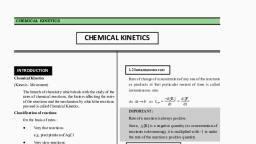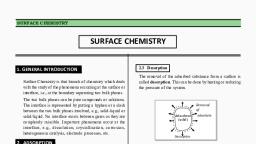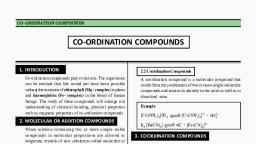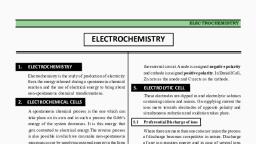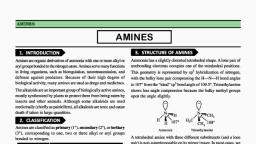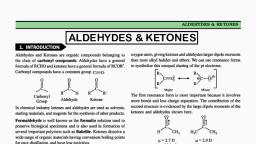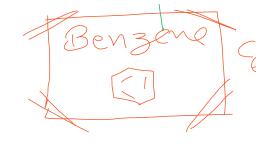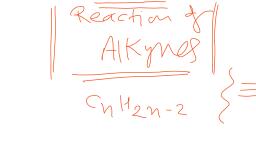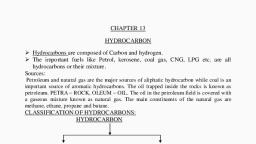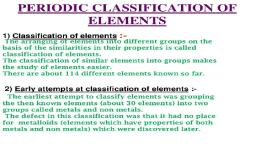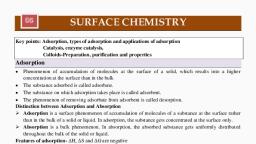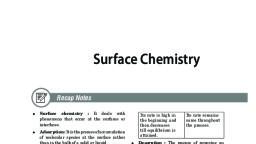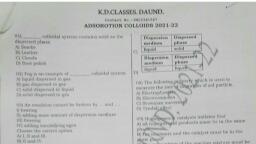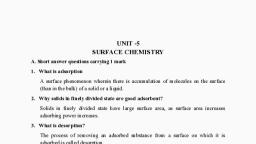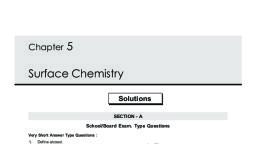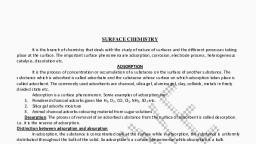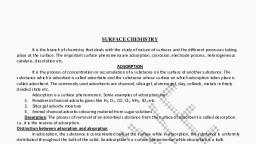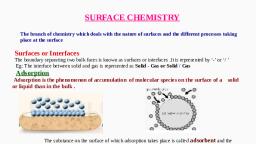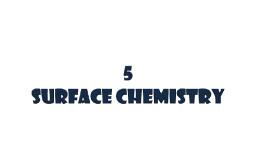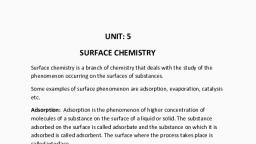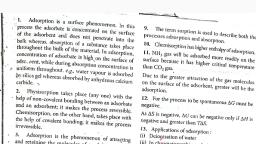Page 1 :
3, , C HA P TE R, , SURFACE CHEMISTRY, , Syllabus, Adsorption - physisorption and chemisorption, factors affecting adsorption of gases on solids,, , colloidal state: distinction between true solutions, colloids and suspension; lyophilic, lyophobic, multimolecular and macromolecular colloids; properties of colloids; Tyndall effect, Brownian movement,, electrophoresis, coagulation., , Learning Outcomes, Differentiate between adsorption and absorption., Compare characteristics of chemisorption and physisorption on the basis of surface area, nature, forces., Draw graph of Freundlich adsorption isotherm., Classify colloids on the basis of nature of interaction, type of particles., Learn mechanism for Micelle formation and cleansing action of soap., Interpret properties of colloidal solutions such as Brownian movement and Hardy-Schulze rule for, coagulation properties., Relate applications of adsorption and colloidal solutions involved in our surrounding environment., , , , , , , , Revision Notes, Adsorption and its Types, Factors Affecting Adsorption, Surface chemistry: The branch of chemistry which deals with the phenomenon that occurs at the surface is called, surface chemistry. This phenomenon is studied with the help of adsorption and colloidal state., Adsorption is a surface phenomenon in which the substance gets accumulated on the surface of a solid rather, than in the bulk of a solid or liquid. The surface that adsorbs is called adsorbent and the one that gets adsorbed is, called an adsorbate. For example: Pt can adsorb large amount of hydrogen gas., Types of adsorption:, , (i) Physisorption: Physisorption is also called physical adsorption. If the adsorbate is held on a surface of, adsorbent by weak Van der Waals forces, the adsorption is called Physical adsorption or physisorption., , (ii) Chemisorption: Chemisorption is also called chemical adsorption. If the forces holding the adsorbate are as, strong as in chemical bonds, the adsorption process is known as Chemical adsorption or Chemisorption., Desorption: The process of removing an adsorbed substance from a surface on which it is adsorbed is called desorption., In absorption, molecules of a substance are uniformly distributed throughout the body of solid or liquid. For, example: Ammonia absorbed by water, water absorbed by anhydrous CaCl2., Sorption: When adsorption and absorption take place simultaneously, it is called sorption, e.g., dying of cotton, fabrics. The dye is adsorbed initially on the surface of cotton fibre, but later the fibre has uniform concentration of, dye throughout.
Page 3 :
Enthalpy of adsorption: Adsorption generally occurs with release in energy, i.e., it is exothermic in nature. The, enthalpy change for the adsorption of one mole of an adsorbate on the surface of adsorbent is called enthalpy or, heat of adsorption., Differences between Adsorption and Absorption:, S. No., , Adsorption, , Absorption, , (i), , It is a surface phenomenon. Adsorbate molecules Absorption occurs in the bulk of absorbing, are held at the surface of adsorbent., substance., , (ii), , The concentration of the adsorbate at the Absorbed material is uniformly distributed throughout, adsorbent is much more than that in the bulk., the bulk. Thus, concentration is same throughout., , (iii), , Initially rate of adsorption is rapid. It decreases Absorption occurs with uniform rate., slowly till equilibrium is attained., , (iv), , Example: Water vapours are adsorbed on Silica Example: Water vapours are absorbed by Anhygel., drous CaCl2. (Calcium Chloride), , Factors affecting adsorption of gases on solids:, (i) Nature of gas, (ii) Nature of adsorbent, (iii) Specific area of the solid, (iv) Pressure of the gas, (v) Effect of temperature, (vi) Activation of adsorbent, Adsorption isobar: A plot of extent of adsorption (x/m) vs temperature at constant pressure is called adsorption, isobar., Adsorption isotherm: The plot of extent of adsorption (x/m) vs pressure (p) at constant temperature is called, adsorption isotherm, where, x is the quantity of gas adsorbed by unit mass ‘m’ of the solid ‘adsorbent’. It is called, adsorption isotherm., Freundlich Adsorption Isotherm: It gives the relationship between magnitude of adsorption (x/m) and pressure, at a constant temperature. It can be given by mathematical equation., x, = kp1/n, ....(i) , m, , , , log, , x, 1, = log k +, log p, m, n, , ...(ii), , x, 1, A plot of log, vs log p gives a straight line with slope, m, n, , and y intercept = log k, In case of solution, the isotherm takes the form, x, x, 1, = k(C)1/n ; log, = log k +, log C, m, m, n, , , where x is the amount of adsorbate adsorbed on (m) gram of adsorbent at pressure p or concentration C of the, adsorbate, k and n are constants where, n > 1., Applications of Adsorption:, , (i) In removing colouring matter from solution, (vii) In curing diseases, , (ii) In gas masks, (viii) In dehumidifiers, (iii) In separating noble gases, (ix) In adsorption analysis, (iv) In dyeing of cloth, (x) In creating high vacuum, (v) In chromatography, (xi) In ion-exchange resins, (vi) In froth flotation process, , (xii) Heterogeneous catalysis, , Colloids, Types of Colloids, Characteristics, and Preparation of Colloids, Colloids: A colloid is a heterogeneous system in which one substance is dispersed (dispersed phase) as very fine, particles in another substance called dispersion medium. The size of colloidal particles is in the range 1–1000 nm., Colloidal solution: A colloidal solution is a heterogeneous system in which a definite substance is distributed in, the form of very small particles as dispersed phase in another substance called dispersion medium, e.g., glue, Ink,, smoke, etc.
Page 4 :
Dispersed phase: Dispersed phase is the component present in small proportion like solute in the solution. e.g.,, Sugar Particles in water., Dispersion medium: The medium in which the colloidal particles are dispersed is called dispersion medium., Crystalloids: The substances whose aqueous solution can pass through the semi-permeable membrane are called, crystalloids., Types of Colloidal solutions:, S. No., , Dispersed phase, , Dispersion medium, , Name, , Examples, , 1., , Solid, , Gas, , Aerosol, , Smoke, dust particles., , 2., , Solid, , Liquid, , Sol, , As2S3, Gold sol, starch, gum,, muddy water., , 3., , Solid, , Solid, , Solid sol, , Coloured gem stones,, alloys, pearls, ruby glass., , 4., , Liquid, , Solid, , Gel, , Jellies, cheese, butter., , 5., , Liquid, , Liquid, , Emulsion, , Milk, Hair cream, Cod liver oil., , 6., , Liquid, , Gas, , Aerosol, , Fog, mist, cloud., , 7., , Gas, , Solid, , Solid foam, , Pumice stone, foam rubber, cork., , 8., , Gas, , Liquid, , Foam, , Whipped, lather., , cream,, , froth,, , some, , soap, , Classification based on nature of interaction between dispersed phase and dispersion medium:, (i) Lyophilic colloids: Lyophilic means ‘‘solvent loving’’. Those substances which when mixed with a suitable, solvent as the dispersion medium directly form the colloidal solution are called lyophilic substances and the, solution thus formed is called lyophilic solution. They are also known as Intrinsic colloids. For example: Gum,, gelatin, starch, rubber; etc., (ii) Lyophobic colloids: Lyophobic means ‘‘solvent hating’’. These are the substances, when mixed with, dispersion medium do not form colloidal solution. Their solution can be prepared only by, special method, such substances are called lyophobic and the solutions formed by them are, called lyophobic solutions. They are also known as extrinsic colloids. For example: metals, and their sulphides., Classification based on the type of particles of the dispersal phase: Multimolecular,, Macromolecular and Associated colloids:, (i) Multimolecular colloids: Multimolecular colloids contain dispersed particles less than 1, nm made of aggregates of many molecules. These are lyophobic colloids. In multimolecular, colloids, particles are held together by weak van der Waals forces. For example: sulphur sol,, gold sol etc., (ii) Macromolecular colloids: Macromolecular colloids are molecularly dissolved solutions of a polymer with, particle size of colloidal range and are lyophilic colloids. In macromolecular colloids, particles are held by, chemical bonds., For example:, (a) Naturally occurring macromolecular colloids (starch, cellulose, proteins and enzymes)., (b) Man made macromolecular colloids (polythene and nylon)., (iii) Associated colloids (Micelles), Micelles: Those colloids which behave as normal strong electrolytes at low concentrations, show colloidal, properties at higher concentrations due to the formation of aggregated particles of colloidal dimensions., Such compounds are also referred to as associated colloids. Surface active agents like soaps and synthetic, detergents belong to this class. They also form ions. Micelles may contain 100 molecules or more., Mechanism of micelle formation: Micelles are generally formed by the specific type of molecules which, have lyophilic as well as lyophobic ends. Such molecules are known as surface active molecules or surfactant, molecules., , Sodium oleate, C17H33COO–Na+ (one of the soaps) is a typical example of such type of molecule. The long, hydrocarbon part of oleate radical (C17H33–) is lyophobic end while COO– part is lyophilic end. When, the concentration of the solution is below its CMC (3 × 10–3 mol L–1), sodium oleate behaves as normal, electrolyte and ionises to give Na+ and C17H33COO– ions. As the concentration exceeds CMC, the lyophobic, part starts preceding away from the solvent and are made to approach each other. However, the polar, C17H33COO– part tend to interact with the solvent. This ultimately leads to the formation of the cluster having
Page 5 :
the dimensions of the colloidal particles. In each such cluster, a large number of (usually 100 or more) oleate, groups are clumped together in a spherical manner so that their hydrocarbon parts interact with one another, but C17H33COO– parts remain projected in water. Hence, the mechanism of micelles formation is same as that, of soap., Preparation of colloidal solution: Colloidal solutions can be prepared by following methods:, , (i) Mechanical dispersion: A suspension of coarsely ground particles prepared in dispersion medium is fed into, a colloidal mill and speed of rotation is adjusted so as to get the particles of colloidal size., , (ii) Electrodispersion: (Bredig’s Arc method): In this method, two rods of the metal (Au, Cu, Pt, Ag) to be, dispersed are kept immersed in cold and a direct electric arc is struck between them. In this way vapours of, metal are formed which then immediately condense to form particles of colloidal size., , Bredig’s Arc method, , (iii) Chemical methods:, , l Oxidation: Solutions of non-metals are prepared by this method; e.g., colloidal solution of sulphur., HNO ( conc. ), , 3, → 2S + 2H2O, 2H2S + 2(O) , , , l Reduction: Metal sols can be prepared by this method; e.g.; Gold sol, 2AuCl3 + 3SnCl2 → 2Au + 3SnCl4, , 2AuCl3+3HCHO+3H2O → 2Au (sol) + 3HCOOH + 6HCl, , l Hydrolysis: Hydroxides sols are prepared by this method; e.g; Fe(OH)3, Al(OH)3, FeCl3 + 3H2O → Fe(OH)3 + 3HCl, , l Double decomposition: This method is used to prepare colloids from inorganic salts; e.g.;, As2O3 + 3H2S → As2S3 + 3H2O, l Exchange of solvent: Some substances which form true solution in one solvent, forms colloidal solution, in another due to lowering of solubility, e.g.; sulphur dissolved in alcohol forms colloidal solution in water, and phenolphthalein dissolved in alcohol forms colloidal solution in water., , l Excessive cooling: The colloidal solution of ice in CHCl3 or ether can be obtained by freezing a solution of, water in solvent. The molecules of water combine to form particles of colloidal size., Peptization: The conversion of precipitate into colloidal solution in presence of peptizing agent is called, Peptization. Peptizing agent is generally an electrolyte., Purification methods of colloidal solutions: Colloidal solution can be purified by following methods:, (i) Dialysis: In dialysis, particles of true solutions can pass through parchment paper or cellophane membrane., On the other hand, Sol particles cannot pass through these membranes. A bag made up of such a membrane, is filled with the colloidal solution and is then suspended in fresh water. The crystalloid particles pass out, leaving behind the colloidal sol., , (a) Arrangement of Oleate ions on the surface of water, at low concentrations of soap, , (b) Arrangement of Oleate ions inside the, bulk of water (ionic micelle) at critical micelle, concentration of soap
Page 6 :
(ii) Electrodialysis: Movement of ions across the membrane can be quickened by applying electric potential, through two electrodes. This method is faster than simple dialysis and known as electrodialysis., –, , Impure, sol, , Distilled, water, , Water + Electrolyte, , Cellophane bag (Dialysing membrane), Fig. 3.Electrodialysis, Electr odialysis, , , (iii) �Ultrafiltration: The process of separating colloidal particles by specially prepared filter papers whose pore, size is reduced by dipping it in colloidal solution (e.g., 4% nitrocellulose in mixture of, alcohol and ether) are known as ultrafiltration., Properties of colloids:, (i) Brownian movement: The zig-zag movement of colloidal particles when seen under, powerful microscope is called Brownian movement., , Brownian Movement, (ii) Tyndall effect: Scattering of light by colloidal particles is called Tyndall effect., Eye, , Tyndall cone, Light, source, , Microscope, Scattered light, Colloidal, solution, , Colloidal solution, , Tyndall effect, (iii) Electrophoresis: The movement of colloidal particles towards one of the electrodes on passage of electricity, through colloidal solution is called electrophoresis., Hardy-Schulze rule:, (i) Opposite charged ions are effective for coagulation., (ii) The coagulating power of electrolyte increases with increase in charge on the ions used for coagulation. e.g.;, Al3+ > Ba2+ > Na+ for negatively charged colloids., [Fe(CN)6]4– > PO43– > SO42– > Cl – for positively charged colloids., , The reciprocal of coagulation value is called coagulating power. i.e., lower the coagulation value, higher will, be coagulating power., Electrokinetic potential or Zeta potential: The potential difference between the fixed layer and diffused layer of, opposite charges is called zeta potential., Coagulation: Coagulation which can be reversed by shaking is called flocculation or coagulation., Coagulating value: The minimum concentration of an electrolyte which is required to cause the coagulation or, flocculation of a sol is known as coagulation value., Coagulation value ∝, , 1, Coagulating power, , , Gold number: The number of milligram of protective colloids which must be added to 10 ml of given Gold sol to, prevent it from coagulation by addition of 1 ml of 10% of NaCl solution.
Page 7 :
Applications of colloids:, (i) Sewage disposal, , (iii) Smoke precipitation, (v) Tanning, , (ii) Purification of drinking water, (iv) Medicines, (vi) Rubber industry, , Distinction between True solution, Colloids and Suspension:, S. No., , True Solution, , Colloids, , Suspension, , 1., , It is homogeneous., , It appears to be homogeneous but It is heterogeneous., actually it is heterogeneous., , 2., , Its particle size is less than 1 nm. Its particle size is 1 nm to 1000 nm., , 3., , It passes through filter paper., , It passes through ordinary filter It does not pass through filter paper., paper but not through ultrafilter., , 4., , It does not show Tyndall effect., , It shows Tyndall effect., , 5., , It has higher value of Colligative It has low value of Colligative It has very low value of Colligative, property., property., property., , 6., , Its particles cannot be seen even Its particles can be seen by powerful Its particles can be seen even with, with powerful microscope., microscope due to scattering of naked eye., light., , Its particles are larger than 1000 nm., , It does not show Tyndall effect, appreciably., , Know the Terms, Saturation pressure: The pressure beyond which adsorption becomes independent of pressure is called as, Saturation pressure., Competitive adsorption: A strong adsorbate gets adsorbed more efficiently as compared to weak adsorbate,, that strong adsorbate can displace already adsorbed one from the surface of the adsorbent and is known as, Competitive adsorption or Preferential adsorption., Optimum pH: Particular pH at which the rate of an enzyme catalysed reaction is maximum., Crystalloids: The substances whose aqueous solution can pass through the Semipermeable membrane., CMC: Critical Micelle Concentration is the concentration of surfactant above which micelle formation takes place., Streaming potential: When a liquid is forced through a porous material or a capillary tube, a potential difference, is set up between the two sides and is known as Streaming potential., Dorn potential: When a particle is forced to move through a resting liquid, a potential difference is set up. It is, known as Dorn potential also called Sedimentation potential., U-number: The number of milligrams of a hydrophilic sol which is sufficient to produce the colour change from, red to blue in 1 cc of gold sol., and it is called as U-number., , (A) OBJECTIVE QUESTIONS, Stand Alone MCQs, Q. 1. Which one of the following is not applicable to, the phenomenon of adsorption?�, U, (A) ΔH > 0, (B) ΔG < 0, (C) ΔS < 0, (D) ΔH < 0, Ans. Option (A) is correct., Explanation: Adsorption is an exothermic, process, so the ΔH of adsorption is always, negative., , 1 Mark Each, , ΔH < 0, ΔG = ΔH – TΔS, ΔG = Change in Gibbs free energy, ΔH = Change in enthalpy, T = Temperature in Kelvin, ΔG = Change in entropy, Since, adsorption is a spontaneous process,, the thermodynamic requirement is at constant, temperature and pressure, ΔG must be negative., So the enthalpy ΔH as well as entropy ΔS of the, system is negative.
Page 8 :
Q. 2. On the basis of data given below predict which, of the following gases shows least adsorption on a, definite amount of charcoal?, Gas, CO2 SO2 CH4, H2, Critical temp/K, 304, 630, 190, �, (A) CO2, (B) SO2, (C) CH4, (D) H2, Ans. Option (D) is correct., , 33, , Explanation: Higher critical temperatures, indicate easily liquefiable gases which are, readily adsorbed as the Van der Waal’s forces, responsible for adsorption of gases on solid, surfaces are stronger near critical temperatures., Q. 3. Which of the following is an example of, absorption?�, U, (A) Water on Silica gel, (B) Water on Calcium Chloride, (C) Hydrogen on highly divided Nickel, (D) Oxygen on Metal surface, Ans. Option (B) is correct., Explanation: Water on calcium chloride gives, hydrochloric acid and calcium oxide. This is an, example of absorption, rest of all are examples, of adsorption., Q. 4. Which is the example of emulsions?, (A) Smoke, (B) Starch, (C) Gold Sol, (D) Hair Cream, Ans. Option (D) is correct., , U, , Explanation: Smoke is colloidal solution of solid, in gas. Starch is lyophobic sol of dispersion, medium, water. Gold sol has dispersed phase, of solid and dispersion medium as liquid. Hair, cream is emulsion having disperse phase, liquid, and dispersion medium of liquid., Q. 5. Extent of adsorption of adsorbate from solution, phase increases with:, U, (A) increase in amount of adsorbate in solution., (B) decrease in surface area of adsorbent., (C) increase in temperature of solution., (D) decrease in amount of adsorbate in solution., Ans. Option (A) is correct., Explanation: Extent of adsorption of adsorbate, from solution phase increases with increase in the, amount of adsorbate in the solution. Therefore,, as amount of adsorbate in the solution increases, interaction of adsorbent which leads to increase, in the extent of adsorption., Q. 6. Which of the following interface cannot be, obtained?, U, (A) Liquid-liquid, (B) Solid-liquid, (C) Liquid-gas, (D) Gas-gas, Ans. Option (D) is correct., Explanation: Gas-gas interface cannot be, obtained because gases are completely miscible, in nature., For example: Air is a mixture of various gases, such as, O2, N2, CO2, etc., , Q. 7. In physisorption, adsorbent does not show, specificity for any particular gas because :, (A) involved Van der Waals forces are universal., (B) gases involved behave like ideal gases., (C) enthalpy of adsorption is low., U, (D) it is a reversible process. , Ans. Option (A) is correct., Explanation: Physisorption is not specific to any gas, as it involves Van der Waal’s forces by which any, gas molecule gets adsorbed on the solid surface., No specific bonds formation takes place as any gas, can be absorbed on the solid surface., Q. 8. Which of the following is not a favourable, condition for Physical adsorption?, U, (A) High pressure, (B) Negative dH, (C) Higher critical temperature of adsorbate, (D) High temperature�, Ans. Option (D) is correct., Explanation: Physical adsorption is a exothermic, process that is favoured at low temperature on, the basis of the Le-chatelier principle., Q. 9. Which of the following is most effective in, coagulating negatively charged hydrated Ferric, Oxide sol?, (A) NaNO3, (B) MgSO4, (C) AlCl3, (D) KCl�, U [CBSE Comptt. Delhi Set-I 2017], Ans. Option (C) is correct., Explanation: Al3+ > Mg2+ > Na+/k+ The, coagulating power of Al3+ is highest due to, charge and small size, therefore, Aluminium, chloride will be required in minimum amount to, coagulate negatively charged Sol of As2S3., Q. 10. Which of the following is most effective in, coagulating positively charged hydrated Ferric, Oxide sol?, (A) NaNO3, (B) Na2SO4, (C) (NH4)3PO4, (D) LiAlH4, U [CBSE Comptt. Delhi Set-II 2017], Ans. Option (C) is correct., Explanation: According to the Hardy-Schulze, rule, for the coagulating of positively charged, Hydrated ferric sol, the coagulating power are in, the order: PO43– > SO42– > NO3–., Q. 11. Which of the following is the most effective in, coagulating positively charged methylene blue, sol?, (A) Na3PO4, (B) K4 [Fe(CN)6], (C) Na2SO4, (D) Al2(SO4)3, �, U [CBSE Comptt. Delhi Set-III 2017], Ans. Option (B) is correct., Explanation: Greater the valence of the, flocculating ion, greater is its ability to bring, coagulation as per Hardy-Schulze rule. Thus, for, positive sol the power of flocculation is in order:, [Fe(CN)6]4– > PO43– > SO42–.
Page 9 :
Q. 12. A colloidal system having a solid substance as, a dispersed phase and a liquid as a dispersion, medium is classified as, ., U, (A) Solid sol, (B) Gel, (C) Emulsion, (D) Sol, Ans. Option (D) is correct., Explanation: Sol is a colloidal system in which, solid is dispersed in a liquid medium. For, example: Paints and Gum., Q. 13. The values of colligative properties of colloidal, solution are of small order in comparison to those, shown by true solutions of same concentration, because of colloidal particles _____________. R, (A) exhibit enormous surface area., (B) remain suspended in the dispersion medium., (C) form lyophilic colloids., (D) are comparatively less in number., Ans. Option (D) is correct., Explanation: Colloidal particles are large in size., So, the number of particles are lesser than a true, solution of the same concentration. Colligative, properties depends upon the number of solute, particles in the solution., Q. 14. Method by which lyophobic sol can be protected :, R, , (A) by addition of oppositely charged sol., (B) by addition of an electrolyte., (C) by addition of lyophilic sol., (D) by boiling.�, Ans. Option (C) is correct., Explanation: Lyophobic sol can be protected by, adding lyophilic sol which forms a layer around, lyphobic particles and hence protects the latter, from electrolytes. Lyophilic sol is known as, protective colloid., Q. 15. Freshly prepared precipitate sometimes gets, R, converted to colloidal solution by:, (A) coagulation., (B) electrolysis., (C) diffusion., (D) peptisation., Ans. Option (D) is correct., Explanation: Peptisation is the process of, converting freshly prepared precipitate into, colloidal solution by shaking with dispersion, medium in the presence of electrolyte, i.e., a, peptizing agent., Q. 16. Which of the following will show Tyndall effect?, U, , (A) Aqueous solution of soap below critical micelle, concentration., (B) Aqueous solution of soap above critical micelle, concentration., (C) Aqueous solution of sodium chloride., (D) Aqueous solution of sugar., Ans. Option (B) is correct., Explanation: Tyndall effect is a characteristic of, colloidal solution in which colloidal particles, , show a coloured appearance when sunlight is, passed through it when seen perpendicularly., Aqueous solution of soap behave as normal, electrolyte at low concentration, but at higher, concentration (above CMC) exhibit a colloidal, behaviour due to formation of aggregates., , ?, , Assertion and Reason Based MCQs, , Directions: In the following questions, a statement of, Assertion (A) is followed by a statement of Reason (R)., Mark the correct choice as:, (A) Both (A) and (R) are true, and (R) is the correct, explanation of (A)., (B) Both (A) and (R) are true, but (R) is not the correct, explanation of (A)., (C) (A) is true, but (R) is false., (D) (A) is false, but (R) is true., Q. 1. Assertion (A): Extent of adsorption of adsorbate, from solution phase increases with increase in, amount of adsorbate in solution., , Reason (R): Freundlich’s equation describes the, behaviour of adsorption from a solution., U, Ans. Option (A) is correct., Explanation: Freundlich’s equation relates, variation of amount of the gas adsorbed by the, adsorbent with pressure at constant temperature., Freundlich’s equation describes the behaviour of, adsorption from a solution., 1, x, Such that,, = kp n, ( n > 1), m, 1, x, = kC n, m, , , where, x = mass of adsorbate, m = mass of adsorbent, p = equilibrium pressure of the gaseous adsorbate, in case of experiments made in gas phase (gas/, solid interaction with gaseous species/adsorbed, species)., C = equilibrium concentration of adsorbate, in case of experiments made with an aqueous, solution in contact with dispersed solid phase, (dissolved species/adsorbed species)., k and n are constants of a given adsorbate and, adsorbent at a given temperature., These relation shows the dependency of extent of, absorption on the concentration of the absorbate, in the solution., Q. 2. Assertion (A): At the equilibrium position in the, process of adsorption ∆H = T∆S., Reason (R): Adsorption is accompanied by decrease, in surface energy., R, Ans. Option (B) is correct., Explanation: Gibb’s Free energy equation, ∆G =, ∆H – T∆S, Adsorption is a spontaneous process so ∆G is, negative. At equilibrium, DG becomes zero and, ∆H = T∆S is attained.
Page 10 :
Q. 3. Assertion (A): Extent of physisorption of a gas, increases with decrease in temperature., Reason (R): Extent of physiorption increases due to, decrease in strength of Van der Waals forces. U, Ans. Option (C) is correct., Explanation: In Physisorption, particles are held, to the surface by the weak Van der Waals forces, of attraction which gets weak due to increase in, temperature. At low temperature, strength of, Van der Waals forces is high and hence, extent of, adsorption is also high., Q. 4. Assertion (A): Activated adsorption is also known, as chemical adsorption or chemisorption., Reason (R): Adsorption involves formation of, chemical bonds between adsorbent and reactants., R, , Ans. Option (A) is correct., Explanation: Activated adsorption is also known, as chemical adsorption or chemisorption as, it involves high energy of activation for the, formation of chemical bonds between adsorbent, and adsorbate., Q. 5. Assertion (A): An ordinary filter paper impregnated, with colloidal solution stops the flow of colloidal, particles., , Reason (R): Pore size of the filter paper becomes, more than the size of colloidal particle., U, Ans. Option (C) is correct., Explanation: Pore size of the filter paper becomes, smaller than the size of colloidal particles hence, colloidal particles do not easily pass through, it on impregnating filter paper with colloidal, solution. This is also called as ultrafilter paper for, ultrafiltration., Q. 6. Assertion (A): Colloidal solutions do not show, brownian motion., , Reason (R): Brownian motion is responsible for, stability of Sols. �, U, Ans. Option (D) is correct., Explanation: Colloidal particles show Brownian, movement that exhibit stirring effect which does, no permit particles to settle down and hence it is, responsible for the stability of colloidal solution., Q. 7. Assertion (A): Detergents with low CMC are more, economical to use., , Reason (R): Cleansing action of detergents involves, the formation of micelles. These are formed when, the concentration of detergents becomes equal to, CMC.�, U, Ans. Option (A) is correct., Explanation: Cleansing of clothes takes place, by micelles and their formation starts at CMC., The lesser is the CMC, the better and more, economical is the detergent., Q. 8. Assertion (A): Coagulation power of Al3+ is more, than Na+ in the coagulation of negative sol., , Reason (R): Greater the valency of the flocculating, ion added, greater is its power to cause precipitation, R, (Hardy-Schulze rule). , Ans. Option (A) is correct., , Explanation: According to Hardy-Schulze law,, the greater is the valency of the coagulating ion,, the more is the power to coagulate the colloidal, solution. Thus, for coagulation of negative sol,, the coagulation power of Al3+ is greater than that, of Na+., Al3+ > Mg2+ > Na+, Q. 9. Assertion (A): Colloidal solutions show colligative, properties., , Reason (R): Colloidal particles are large in size. R, Ans. Option (B) is correct., Explanation: Colloidal particles are large in size, and hence the number of particles are lesser than, the true solution. The lesser number of particles, results in the lowering of colligative properties., Q. 10. Assertion (A): Colloidal solution are stable sols., , Reason (R): Brownian movement has a stirring, effect, which does not allow the particles to settle, down. , U, Ans. Option (A) is correct., Explanation: Colloidal solution are stable sols, due to Brownian movement which is the, movement of colloidal particles striking against, the dispersion medium. It prevents them from, settling down., , Case-based MCQs, I. R, � ead the passage given below and answer the, following questions:, (1×4 = 4), The amount of moisture that leather adsorbs or, loses is determined by the temperature, relative, humidity, degree of porosity and the size of the, pores. Moisture has great practical significance, because its amount affects the durability of leather, and the comfort of the wearer in articles such as, shoes, gloves and other garments. High moisture, content accelerates deterioration and promotes, mildew action. On the other hand, a minimum, amount of moisture is required to keep leather, properly lubricated and thus, prevent cracking., The study indicates that adsorption of moisture, by leather is a multi-molecular process and is, accompanied by low enthalpies of adsorption., Further at 75 percent relative humidity, the, adsorption is a function of surface area alone., Untanned hide and Chrome tanned leathers have, the largest surface areas. The leathers tanned, with vegetable tanning materials have smaller, surface areas since they are composed of less hide, substance and the capillaries are reduced to smaller, diameters in some cases probably completely filled, by tanning materials. This process of tanning occurs, due to mutual coagulation of positively charged, hide with negatively charged tanning material., The result of the study indicated that untanned, hide and Chrome tanned leather adsorb most of, the water vapour., [CBSE SQP 2020-21], In these questions a statement of Assertion, followed by a statement of Reason is given. Choose, the correct answer out of the following choices.
Page 11 :
(A) A, �ssertion and reason both are correct, statements and reason is correct explanation, for assertion., (B) Assertion and reason both are correct, statements but reason is not correct explanation, for assertion., (C) Assertion is correct statement but reason is, wrong statement., (D) Assertion is wrong statement but reason is, correct statement., Q. 1. �Assertion (A): Vegetable tanned leather cannot, adsorb a large amount of moisture., , �Reason (R): Porous materials have higher surface, area. U, Ans. Option (B) is correct., Explanation: Vegetable tanned leather cannot adsorb, a large amount of moisture as these leathers have, smaller surface areas since they are composed of, less hide substance and the capillaries are reduced to, smaller diameters in some cases probably completely, filled by tanning materials whereas porous materials, have higher surface area such as cotton sponge,, wood., Q. 2. �Assertion (A): Animal hide soaked in tannin results, in hardening of leather., , �Reason (R): Tanning occurs due to mutual, coagulation. R, Ans. Option (A) is correct., Explanation: Animal hides are colloidal in nature., When (positively charged) animal hides are, soaked in (negatively charged colloidal particles), tannin, mutual coagulation takes place. That, results in hardening of leather., Q. 3. �Assertion (A): Adsorption of moisture by leather is, physisorption., , �Reason (R): It is a multimolecular process and is, accompanied by low enthalpies of adsorption. U, Ans. Option (A) is correct., Explanation: Multi-molecular process of adsorption, of moisture by leather is called physisorption. It, is an exothermic process and is accompanied by, low enthalpies of adsorption. This is because, the attraction between gas molecules and solid, surface is due to weak Van der Waal’s forces., Q. 4. �Assertion (A): Leathers tanned with vegetable, tanning materials have smaller surface areas., , �Reason (R): The capillaries present in leather are, reduced to smaller diameters. U, Ans. Option (A) is correct., Explanation: Leathers tanned with vegetable, tanning materials have smaller surface areas, because on tanning leather, the capillaries present, in leather are reduced to smaller diameters or, completely filled by tanning material., OR, Q. 5. �Assertion (A): Leather absorbs different amount of, moisture., , , �Reason (R): Some moisture is necessary to prevent, cracking of leather. , Ans. Option (B) is correct., Explanation: The different amount of moisture, that leather adsorbs or loses is determined, by temperature, relative humidity, degree of, porosity, and size of the pores. The leather, properties of elasticity and softness require, certain amount of moisture. Thus, a minimum, amount of moisture (i.e., uniform temperature, 15-20°C, relative humidity 50-70%) is required, to keep leather properly lubricated and thus, prevent cracking., II. R, � ead the passage given below and answer the, following questions:�, U, Some colloids are stable by their nature, i.e., gels,, alloys, and solid foams. Gelatin and jellies are the, two common examples of a gel. The solid and liquid, phases in a gel are interpersed with both phases, being continuous. In most systems, the major, factor influencing the stability is the charge on the, colloidal particles. If a particular ion is preferentially, adsorbed on the surface of the particles, the, particles in suspension will repel each other,, thereby preventing the formation of aggregates, that are larger than colloidal dimensions. The ion, can be either positive or negative depending on, the particular colloidal system, i.e., air bubbles, accumulate negative ions. Sulphur particles have, a net negative charge in a sulphur sol, and the, particles in a metal hydroxide sol are positively, charged. Accumulation of charge on a surface is not, as usual phenomenon of dust attracted to furniture, surfaces by electrostatic forces. When salts are, added to lyophobic colloidal systems the colloidal, particles begin to form larger aggregates and a, sediment forms as they settle. This phenomenon, is called flocculation, and the suspension can be, referred to as flocculated, or colloidally unstable. If, the salt is removed, the suspension can usually be, restored to its original state; this process is called, Deflocculation or Peptization. The original and, restored colloidal systems are called deflocculated,, peptized, or stable sols., Addition of small amount of salt affects the, stability of colloidal system because of attractive, and repulsive forces that exist between colloidal, particles. Van der Waals forces are responsible for, the attractions, while the repulsive forces are due, to the surface charge on the particles. In a stable, colloid, the repulsive forces are of greater magnitude, than the attractive forces. The magnitude of the, electrical repulsion is diminished by addition of, ionized salt, which allows the dispersed particles to, aggregate and flocculate. River deltas provide an, example of this behaviour., Q. 1. Gelatin is a ________________ colloidal system., (A) Solid in solid, (B) Solid in gas, (C) Liquid in solid, (D) Liquid in gas, R, Ans. Option (C) is correct.
Page 12 :
Explanation: Gelatin sets on cooling and, the whole mass (including liquid) sets to an, extremely viscous body (gel). Thus, gelatin is a, colloidal sol of liquid (dispersed phase) in the, solid (dispersion medium)., Q. 2. Colloidal solutions are stable due to:, (A) presence of charges on the colloidal particles., (B) formation of aggregates by colloidal particles., (C) preferential adsorption on the surface., (D) preferential absorption on the surface., U, Ans. Option (A) is correct., Explanation: The stability of colloidal solutions, depend upon the charges present on the, dispersed phase and dispersion medium. Due, to formation of sheath of charges (identical),, it prevents the attraction between opposite, charges and hence double layer is formed. This, layer prevents the coagulation of colloid, making, colloidal solutions stable., Q. 3. Settling down of colloidal particles to form a, suspension is called:, (A) Flocculation, (B) Precipitation, (C) Aggregation, (D) All of the above U, Ans. Option (D) is correct., , (B), , SUBJECTIVE, , Explanation: The process of settling down of, colloidal particles to form suspensions is called, coagulation or precipitation or aggregation., Q. 4. When Van der Waals forces are greater than forces, due to the surface charge on the particles:, (A) Flocculation occurs., (B) The colloid is stable., (C) Peptization takes place., (D) Deflocculation occurs. , U, Ans. Option (A) is correct., OR, Q. 5. The particles in suspension will repel each other,, thereby preventing the formation of aggregates, that are larger than colloidal dimensions. This, statement explains: , (A) formation of delta., (B) river water as a colloidal solution of clay, particles., (C) effect of salt on lyophobic colloid., (D) phenomenon of flocculation., Ans. Option (A) and (B) are correct., Explanation: When river water comes in contact, with sea water, the electrolytes present in, sea water coagulates the suspended colloidal, particles which settle down at point of contact to, form delta., , QUESTIONS, , Short Answer Type Questions-I, (2 Marks Each), Q. 1. (i) Define adsorption with an example., U, , [O.E.B.], , (ii) Write one similarity between Physiorption and, Chemisorption.�, R [CBSE D/OD 2017], Ans. (i) The phenomenon of accumulation of higher, concentration of the molecular species on the surface, of the solid than in the bulk is called adsorption. e.g., Activated charcoal adsorbs a number of gases like, ammonia, phosgene etc., (ii) Both are surface phenomenon / both increase, with increase in surface area (or any other correct, similarity)., Q. 2. Define Brownian movement. What is the cause of, Brownian movement in colloidal particles? How is, it responsible for the stability of Colloidal sol?�, R [CBSE Delhi Set-1 2020], Ans. Brownian movement: The particles of the dispersed, phase of colloidal solution execute a continuous zigzag motion. This phenomenon is called Brownian, movement., Cause of Brownian movement: The dispersed phase, particles of the colloidal solution are constantly, collided by the molecules of the dispersion medium., Brownian movement opposes the force of gravity, on the colloidal particles. So, these particles always, remain in a state of motion and do not settle., , Q. 3. �What do you understand by an adsorption, isotherm? Give a brief description of, [O.E.B.], Freundlich’s isotherm.�, R, Ans. A graph drawn between extent of adsorption of, gas on the adsorbent and the pressure of the gas at, constant temperature is called adsorption isotherm., , , �An empirical relationship between the amount of, gas adsorbed by unit mass of solid adsorbent (x/m), and the equilibrium pressure (p) can be given by, x, = kp1 / n, m, , , �where, n is a positive integer and k is the constant., , Taking log both the sides,, x, 1, , We get, log = log k + log P, n, m, , This is known as Freundlich adsorption isotherm., , Commonly Made Error, , , , Students often plot the graph and do not write the, variables., Student forget to use logarithm and plot correct graph.
Page 13 :
Answering Tip, , , , While plotting a graph, both the independent and, dependent variables must be written., Always write x-axis, y-axis representation with, x, log, log y., m, , Q. 4. With the help of an example, explain how, physisorption changes to chemisorption with rise, in temperature? Give the reason for the change.�, U, , [O.E.B.], , Ans. Adsorption of hydrogen gas on finely divided, nickel is physisorption at low temperatures as it, involves weak Van der Waals forces. With the rise, in temperature, hydrogen molecules dissociate to, form hydrogen atoms which are held on the surface, by chemisorption., Q. 5. (i) How does the precipitation of colloidal smoke, take place in Cottrell precipitator?� R, [O.E.B.], (ii) Freundlich adsorption isotherm is given by the, expression x/m = kp1/n What conclusions can be, [O.E.B.], drawn from this expression?�, Ans. (i) In Cottrell precipitator, charged smoke particles, are passed through a chamber containing plates, with charge opposite to the smoke particles. Smoke, particles lose their charge on coming in contact to, the plates and get precipitated. Hence, particles, settle down on the floor of the chamber., (ii) �, Following conclusions can be drawn from the, equation:, (a) �When 1/ n = 0, the adsorption is independent of, pressure., (b) �When n = 1, x/m vs p graph is a straight line with, x, slope 1. This show, ∝ p , means adsorption is, m, dependent upon the pressure directly., (or any other correct conclusion), Q. 6. (i) Why is Chemisorption referred to as activated, adsorption?�, [O.E.B.], U, (ii) What type of colloid is formed when a liquid is, dispersed and a solid is in dispersion? Give an, example., R [CBSE OD Set-2 2019], Ans. �(i) Chemisorption involves formation of bonds, between the solid surface (adsorbent) and gaseous, atoms/molecules (adsorbate). Since formation of, chemical bonds requires high activation energy, it, is known as activated adsorption., (ii) Gel is a colloidal solution in which liquid is, dispersed in a solid dispersion medium. ExampleCheese / butter., Q. 7. Explain the following:, (i) Same substance can act both as colloids, and crystalloids., (ii) Artificial rain is caused by spraying salt over, clouds.�, [O.E.B.], A&E, , Ans. (i) The nature of the substance whether colloid, or crystalloid depends upon size of the solute, particles. When the size of solute particles, lies between 1 nm to 1000 nm, it behaves as a, colloid. Whereas size of particles is less than, 1 nm, it behaves as crystalloids.�, (ii) The colloidal particles of the clouds that carry, charges, get neutralized and coagulated to, bigger water drops by spraying salt over clouds, and as a result artificial rain is occurred., Q. 8. (i) Why are medicines more effective in colloidal, state?, (ii) What is the difference between an emulsion and a, gel?, R [ CBSE Delhi Set-2 2019], Ans. (i) Due to large surface area these are easily, assimilated or adsorbed., (ii) Emulsion – Both dispersed phase and dispersion, medium are liquid. Example – Milk., Gel- Dispersed phase is liquid while Dispersion, medium is solid. Example – Butter., [CBSE Marking Scheme, 2019], Q. 9. Write the main reason for the stability of colloidal, sols., R [CBSE OD Set-3 2019], Ans. The colloidal particles carry same charge which, can be either positive charge or negative charge., The similar charged colloidal particles repel each, other. This prevents from aggregating when these, particles come closer to each other., Q. 10. Define the following terms:, (i) Desorption, (ii) Critical Micelle Concentration, , R, , Ans. (i) �, The process of removing an adsorbed, substance from a surface on which it is, adsorbed.�, [1], (ii) �The formation of micelles takes place only, above a particular concentration called CMC., �, [1], , Commonly Made Error, , , Students often write irrelevant information thus, losing time. Concise answer saves time., , Answering Tip, , , As it is a 3 marks question, just write the definition, of each., Q. 11. (i) �Write the expression for Freundlich’s equation to describe the behaviour of adsorption, from solution phase., (ii) What causes charge on sol particles?�, , U, [O.E.B.], , Ans. (i) Frendlich adsorption isotherm,, , x, 1, = kC n, m, , x, Where,, = quantity of gas adsorbed in unit mass, m, of, solid adsorbent, , C = equilibrium concentration
Page 14 :
k, n = constants at a given temperature, (ii) The charge on the sol particles is due to:, , (a) �, Electron capture by sol particles during, electrodispersion., , (b) �Preferential adsorption of ions from solution., , (c) Formulation of electrical double layer., Q. 12. Write one difference in each of the following:, (i) Lyophobic sol and Lyophilic sol, (ii) Solution and Colloid, U [CBSE Delhi Set-1, 2017], Ans.(i) �Lyophobic sols are liquid (dispersion medium)hating and lyophillic sols are liquid (dispersion, medium)-loving colloids.�[1], (ii) �, Solution is a homogeneous mixture while, colloid is heterogeneous mixture/does not show, Tyndall effect.�[1], , (or any other correct difference), , [CBSE Marking Scheme 2017], Detailed Answer:, (i), Lyophobic sol, , Lyophilic sol, , These are also called These are also called, irreversible sols., reversible sols., These are unstable These are quite stable, and can be easily and cannot be easily, coagulated., coagulated., , �, (ii), , Solution, , Colloid, , These are homogeneous. These are heterogeneous., In the solutions, the In the colloid, the, particles are ions and particles, are, either, molecules., single macromolecules, or, aggregates, of, molecules or atoms., , �, , Commonly Made Error, , , Students write more than one point of difference,, which is not required, as each part carries just one, mark., , Answering Tip, , , Write short, concise one difference only as each subquestion carries only 1 mark., , Q. 13. Define the following terms:, , (i) Protective colloid, , (ii) Zeta potential , R, Ans. (i) Protective colloid: The process by which the, lyophobic sols are protected from coagulation, by electrolytes due to the previous addition of, a lyophilic colloid is called protection and the, colloids are called Protective colloids., (ii) Zeta potential: It is the potential difference between, the dispersion medium and the stationary layer of, fluid attached to the dispersed particle., Q. 14. Write one difference in each of the following:, , (a) Multimolecular colloid and associated, colloid, , (b) Coagulation and peptization, Ans. (a), Multimolecular colloid, , Associated colloid, , Aggregation of large Aggregation of large, number of small atoms or number of ions in conmolecules., centrated solutions., (b) �, , [1], , Coagulation, , Peptization, , Settling down of, colloidal particles., , Conversion of precipitate, into colloidal sol by adding, small amount of electrolyte., [1], [CBSE Marking Scheme, 2017], , Detailed Answer:, , (a) Multimolecular colloids are formed by the, aggregate of a large number of molecules which, generally have diameter less than nm. e.g.; Sols, of gold.�, , Associated colloids are formed by aggregation, of a large number of ions in concentrated, solution. e.g., Soap sol., , (b) Coagulation is a process of agitating together, the colloidal particles so as to change them into, large sized particles which ultimately settle as, precipitate., , Peptization is the process of converting a fresh, precipitate into colloidal particles by shaking it, with the dispersion medium in the presence of, a small amount of suitable electrolyte., Q. 15. Write one difference between each of the following:, , (i) Multimolecular colloid and Macromolecular, colloid, , (ii) Sol and Gel, R, , Ans. (i), Multimolecular colloid Macromolecular colloid, These, colloids, are, formed when small, particles aggregate to, form a particle having, size in colloidal range., , These are substances,, whose, individual, molecules have very, large size with colloidal, dimensions., , Example – Gold sol., , Example – Starch., , , (ii), Sol, , Gel, , A colloidal system, in which dispersed, phase is a solid and, Dispersion medium is, a liquid., , A, colloidal, system, in which Dispersed, phase is a liquid and, Dispersion medium is a, solid., , Example – Paints., , Example – Cheese., , Q. 16. Give reasons for the following observations:, (i) Leather gets hardened after tanning., (ii) Lyophilic sol is more stable than Lyophobic sol., A&E [CBSE Delhi 2015]
Page 15 :
(ii), Sol, , Gel, , A colloidal system, in which dispersed, phase is a solid and, Dispersion medium is, a liquid., , A, colloidal, system, in which Dispersed, phase is a liquid and, Dispersion medium is a, solid., , Example – Paints., , Example – Cheese., , Q. 16. Give reasons for the following observations:, (i) Leather gets hardened after tanning., (ii) Lyophilic sol is more stable than Lyophobic sol., A&E [CBSE Delhi 2015], Ans. (i) Mutual coagulation.�, [1], (ii) �Strong interaction between dispersed phase, and Dispersion medium or solvated layer.� [1], [CBSE Marking Scheme 2015], Detailed Answer:, (i) Animal hides are colloidal in nature. When a hide, which has positively charged particles, is soaked in, tannin, which contains negatively charged colloidal, particles, mutual coagulation takes place. This, results in the hardening of leather.�, (ii) Lyophilic colloids have great affinity for the, Dispersion medium i.e., Dispersed phase particles, are solvated to a greater extent in case of lyophilic, colloids. Hence, lyophilic sols are relatively more, stable than lyophobic sols. �, Q. 17. (a) �, A colloidal sol is prepared by the method in, given figure. What is the charge of AgI colloidal, particles in the test tube? How is the sol formed,, represented?, 3, , Short Answer Type Questions-II, (3 Marks Each), Q. 1. Write any three differences between Physisorption, and Chemisorption.�, U [CBSE OD 2015], OR, Write three differences between Physisorption and, Chemisorption.�, U [CBSE Foreign Set-1, 2 2017], , Ans., S. No., (i), , Physisorption, Chemisorption, Due to Van der Waals Due to chemical bond, forces, formation, , (ii), , Reversible, , (iii), , Enthalpy of adsorption Enthalpy of adsorption, is low (20-40 kJ/mol., is high (80-240 kJ/mol., , Irreversible, , [1+1+1], [CBSE Marking Scheme 2017], Detailed Answer:, S. No., Physisorption, (i) It arises by weak van, der Waals forces., (ii) It usually takes place at, a low temperature and, decreases with increase, in temperature., , Chemisorption, It arises by strong forces like chemical bond., It takes place at a, high temperature and, increases with increase, in temperature., , (iii), , It is reversible., , It is irreversible., , (iv), , It depends on the ease, of liquification of the, gas., , The extent of adsorption, is not related to, liquification of the gas., , (v), , It is not very specific., , It is highly specific., , (vi), , It forms multimolecular layers., , It forms monomolecular layers., , (vii), , It does not require any It requires activation, energy., activation energy., (Any three), , [O.E.B.], , Q. 2. (a) �Write the dispersed phase and dispersion, medium of milk., (b) Why is adsorption exothermic in nature?, (c) �Write Freundlich adsorption isotherm for gases, at high pressure.�, U [CBSE OD Set-2 2019], , (b) �Which of the following electrolytes is the most, effective for the coagulation of Fe(OH)3 sol which, is a positively charged sol ?, , NaCl, Na2SO4, Na3PO4 U, [O.E.B.], Ans. (a) Negative charge is developed on the sol,, , Sol is represented as AgI /I–, (b) Na3PO4, , Hardy-Schulze rule., , Ans. (a) �Dispersed phase = liquid, Dispersion medium = liquid, (b) �Due to the formation of new bonds / force of, attraction between adsorbate and adsorbent, x, (c), = kp° = k�[1 × 3 = 3], m, [CBSE Marking Scheme, 2019], Detailed Answer:, (a) Dispersed phase in milk - Liquid/oil., Dispersion medium in milk - Liquid/water.
Page 16 :
(b) �, When adsorption leads to a decrease in the, residual forces on the surface of the adsorbent,, it causes a decrease in the surface energy of, the adsorbent. Therefore, adsorption is always, exothermic., (c), , Freundlich isotherm for adsorption,, , , , At high pressure, x µ p°, , 1, x, = kp n, m, , m, , , But freundlich isotherm is valid for limited pressure, that is verified by freundlich isotherm curve. At, higher pressures, rate of adsorption saturates and, fails to explain freundlich isotherm., x, —, m, , , Commonly Made Error, , , p, Adsorption, Isotherm, , Sometimes, students do not write correct equation for, Freundlich adsorption isotherm at high pressure. They, often use concentration term in place of pressure., , Answering Tip, , , Learn and understand Freundlich adsorption isotherm, on the basis of pressure., , Q. 3. (a) �Write the dispersed phase and Dispersion, medium of butter., (b) �Why does physisorption decrease with increase, in temperature?, (c) �, A colloidal sol is prepared by the method, given in the figure. What is the charge on AgI, colloidal particles formed in the test tube?, How is this sol represented?, AgNO3 solution, , �, , KI solution, , U [CBSE OD Set-3 2019], , Ans. (a) Dispersed phase = Liquid, , Dispersion medium = Solid/liquid�, [1], (b) �Because physisorption is exothermic in nature, and with rise in temperature, desorption starts., �, [1], (c) Negatively charged , AgI/I–�, [½ + ½], [CBSE Marking Scheme, 2019], Detailed Answer:, , (a) Dispersed phase: Liquid, , Dispersion medium: Solid, (b) Physisorption decrease with increase in temperature, because it is an exothermic reaction., (c) �When AgNO3 solution is added to KI solution,, negatively charged sol of AgI is formed due to, elective adsorption of I– ion from the dispersion, medium. It is represented as given below., , AgI/I– is Negatively charged., Q. 4. Write three differences between lyophobic sol and, [O.E.B.], lyophilic sol., R, Ans. Differences between lyophobic and lyophilic sol:, S., No, , Lyophobic sol, , Lyophilic sol, , 1., , These are irreversible., , These are reversible., , 2., , They exhibit Tyndall, effect., , They do not exhibit, Tyndall effect., , 3., , These are unstable and, hence require traces of, stabilisers., , These are self, stabilised., , Q. 5. (a) �Write the dispersed phase and dispersion, medium of dust., , (b) �Why does Physisorption reversible whereas, Chemisorption is irreversible?, , (c) �, A colloidal sol is prepared by the method, given in the figure. What is the charge on AgI, colloidal particles formed in the test tube?, How is this sol represented? , R, KI Solution, , AgNO3, solution, U [CBSE OD Set-3 2019], , Ans. (a) �Dispersed phase = Liquid; Dispersion, medium = Gas�[1], (b) Due to weak Van der Waal’s forces in, physisorption whereas strong chemical forces in, chemisorption., [1], (c) Positively charged , AgI/Ag+, [½ + ½], [CBSE Marking Scheme, 2019], Q. 6. (a) Write the dispersed phase and dispersion, medium of milk., (b) Write one similarity between physisorption, and chemisorption., (c) Write the chemical method by which Fe(OH)3, sol is prepared from FeCl3., , R+U, , [O.E.B.]
Page 17 :
Ans. (a) Dispersed phase-liquid, medium-liquid., , and, , Dispersion, [1], , Ans.(i), S. No., , (b) Both are surface phenomena/both increase, with increase in surface area (or any other, correct similarity), [1], , (a), , hydrolysis, , → Fe(OH)3 (sol)+ 3HCl, , , , [CBSE Marking Scheme, 2017] [1], , Detailed Answer:, , (a) Dispersed phase of milk: Liquid, , , It is a surface, phenomenon., , (b), , (c) Hydrolysis, FeCl3 + 3H2O, , , Adsorption, , The accumulation, of molecular species, at the surface rather, than in the bulk of, a solid or liquid is, called as Adsorption., , Absorption, It is a bulk phenomenon., The substance is, uniformly distributed, throughout the bulk, of the solid essentially, a bulk phenomenon., , [1], , Dispersion medium of milk: Liquid, , , (b) Physisorption and chemisorption depend on, the nature of the gas / both are exothermic, processes.�, (c) A red sol of Fe(OH)3 is obtained by adding some, ferric chloride to a beaker of boiling water., FeCl3 + 3H2O → Fe(OH)3 + 3HCl, , (ii) AlCl3 is more effective in causing coagulation, of negatively charged sol because according to, Hardy and Schulze rule, greater the valency of, the flocculating ion, greater is its ability to bring, coagulation., , [1], (iii) Sulphur sol forms multimolecular colloids.�[1], , , [CBSE Marking Scheme 2016], Q. 9. Answer the following questions:, , Q. 7. Define the following terms:, , (i) What happens when a freshly precipitated Fe(OH)3, is shaken with a little amount of dilute solution of, FeCl3 ?, , (i) Lyophilic colloid,, (ii) Zeta potential,, (iii) Associated colloids.�, , R [CBSE OD 2016], , Ans. (i) �Lyophilic colloid: Liquid loving colloidal sols, , (ii) Why are lyophilic colloidal sols more stable than, lyophobic colloidal sols ?, , directly formed by mixing substances like gum,, , (iii) What form Freundlich adsorption equation will, , gelatin, starch, rubber, etc., with a suitable liquid, (the dispersion medium) are called lyophilic sols., e.g., muddy water., (ii) �Zeta, , potential:, , The, , potential, , take at high pressure ?, , (ii) Stability of lyophilic sols is due to:, , difference, , between the fixed layer and the diffused layer, , , (a) same charge on all the colloidal particles., , of opposite charges is called the Electrokinetic, , , (b) solvation of the colloidal particles., (iii) �At high pressure amount of gas adsorbed (x/m), becomes independent of pressure (p)., x, = k × p°, m, , potential or Zeta potential., (iii) A, � ssociated colloids: There are some substances, which at low concentrations behave as normal, strong electrolytes, but at higher concentrations, , Freundlich isotherm fails at high pressure, because, rate of adsorptions saturates at high pressure., , exhibit colloidal behaviour due to the formation of, aggregates. The aggregated particles thus formed, are called Associated colloids or Micelles., Q. 8. (i) �Differentiate, , between, , Adsorption, , and, , Absorption., (ii) �Out of MgCl2 and AlCl3, which one is more, effective in causing coagulation of negatively, charged sol and why ?, (iii) �Out of sulphur sol and proteins, which one, forms multimolecular colloids ?, �, , [O.E.B.], , Ans. (i) A, � reddish brown coloured colloidal solution is, obtained., , U [CBSE Delhi 2016], , Q. 10. Explain the following phenomenon giving reasons:, (i) �Chemical adsorption increases with increase, in temperature., (ii) Alum is applied on a cut to stop bleeding., (iii) Sky appears blue in colour., �, , A&E [CBSE Comptt. OD Set-3 2017], , Ans. (i) High energy of activation is needed. �, [1], (ii) �Blood being a colloidal solution, gets, coagulated by alum (an electrolyte).�, [1], (iii) �Dust particles along with water suspended in, air scatter blue light which reaches our eyes. [1], �, [CBSE Marking Scheme 2017]
Page 18 :
Detailed Answer:, , Ans. (a) Peptization occurs / Colloidal solution of, Fe(OH)3 is formed. �, [1], (b) Coagulation occurs.�, [1], (c) Demulsification or breaks into constituent liquids., [1], [CBSE Marking Scheme 2018], , (i) I� ncrease in temperature provides high energy, of activation required in chemical adsorption to, form chemical bonds., (ii) I�t is due to coagulation of blood. Alum acts as, an electrolyte which coagulates blood because, blood is a colloidal solution., , Detailed Answer:, (a) When a freshly prepared precipitate of Fe(OH)3, is shaken with a small amount of FeCl3 solution,, peptisation occurs by converting the Fe(OH)3, precipitate into colloidal solution of positively, charged Fe(OH)3., , (iii) �, The light gets incident on the atmospheric, particles scatters the sunlight. Due to larger, scattering of blue colour, sky appears blue in, colour., Q. 11. Give reason for the following observations:, (i) �When silver nitrate solution is added to Potassium, Iodide solution, a negatively charged colloidal, solution is formed., , (b) On persistent dialysis, the electrolyte present is, completely removed resulting in the coagulation of, the colloidal solution., , (ii) �Finely divided substance is more effective as an, adsorbent., , (c) On centrifugation, an emulsion gets separated into, its constituent liquids., , (iii) Lyophilic colloids are also called reversible sols., �, , A&E [CBSE Comptt. Delhi/OD 2018], , Ans. (i) The precipitated Silver Iodide adsorbs Iodide, ions from the Dispersion medium resulting in, the negatively charged colloidal solution. [1], (ii) Due to large surface area., [1], (iii) �If the dispersion medium is separated from the, dispersed phase, the sol can be reconstituted, by simply remixing with the dispersion, medium. That is why, these sols are also called, reversible sols. �, [1], , [CBSE Marking Scheme 2018], , Q. 13. (i) What is the role of activated charcoal in gas, mask?�, (ii) �A colloidal sol is prepared by the given method, in figure. What is the charge on hydrated Ferric, Oxide colloidal particles formed in the test tube?, How is the sol represented?, FeCl3, Solution, , NaOH, Solution, , Q. 12. What happens when, , (iii) How does Chemisorption vary with temperature?, , (a) �a freshly prepared precipitate of Fe(OH)3 is shaken, with a small amount of FeCl3 solution ?, (b) �persistent dialysis of a colloidal solution is carried, out ?, (c) an emulsion is centrifuged ?, �, , U [CBSE Delhi/OD 2018], , U [CBSE Delhi Set-1 2019], , Ans. (i) Adsorption of toxic gases., (ii) Negative charge ; Fe2O3.xH2O/OH–, , [1], [½ + ½], , (iii) Increases with increase in temperature/ First, increases then decreases., [CBSE Marking Scheme, 2019] [1], , OR, Ans. (a)
Page 19 :
(b), , (c), , [Topper’s Answer 2018], Detailed Answer:, (i) �, The activated charcoal adsorbs the poisonous gases, rather than oxygen and provides fresh oxygen for, inhaling., (ii) �, When ferric chloride is added to NaOH, a negatively, charged sol is formed with adsorption of OH– ions., , The sol is represented as [Fe(OH)3]OH–., (iii) �, Adsorption is an exothermic process. According, to Le-Chatelier’s principle at low temperature,, forward reaction is favourable. As temperature, increases, enough energy is being provided for the, molecules to reach the activation energy. Therefore,, initially as temperature increases chemisorption, increases. As the high temperature helps in bond, breaking after certain temperature, chemisorption, decreases. �, Q. 14. Answer the following questions:, (a) Which of the following electrolytes is most, effective for the coagulation of AgI/Ag+ sol?, MgCl 2 , K 2 SO4 , K 4 [Fe(CN) 6], (b) �What happens when a freshly precipitated Fe(OH)3, is shaken with a little amount of dilute solution of, FeCl3?, (c) Out of Sulphur sol and Proteins, which one forms, Macromolecular colloids?, R [CBSE SQP-2020], Ans. (a) K4[Fe(CN)6] �, [1], (b) Fe(OH)3 is converted into colloidal state by, preferential adsorption of Fe3+ ions.�, [1], (c) Proteins �, [1], �, [CBSE SQP Marking Scheme 2020], Detailed Answer:, (a) According to the Hardy-Schulze rule, greater, the valence of the flocculating ion, greater, , is its ability to bring coagulation. Thus,, K4[Fe(CN)6] is most effective in coagulation of AgI/, Ag+ sol.�, (c) Macromolecular colloids are molecularly dissolved, solutions of a polymer with particle size of colloidal, range. Proteins are polymers of amino acids and, form macromolecular colloids., , Long Answer Type Questions, (5 Marks Each), Q. 1. �, Differentiate between multi-molecular and, macro- molecular colloids. Name one example of, each. How does associated colloids differ from, [O.E.B.], these two colloids?�, U, Ans. (i) �In multi-molecular colloids, the colloidal particles, are aggregate of atoms or small molecules with a, diameter of less than 1nm. The molecules in the, aggregate are held together by Van der Waals, forces of attraction. Examples of such colloids, include Gold sol and Sulphur sol., (ii) �In macro-molecular colloids, the colloidal particles are large molecules having colloidal dimensions. These particles have a high molecular mass., When these particles are dissolved in a liquid, sol, is obtained., , For example : Starch, Nylon, Cellulose, etc., (iii) �Certain substances tend to behave like normal, electrolytes at lower concentrations., , However, at higher concentrations these, �, substances behave as colloidal solutions due, to the formation of aggregated particles. Such, colloids are called aggregated colloids.
Page 20 :
Q. 2. �Define the following:, (i) Gold Number, (ii) Hardy-Schulze rule, (iii) Zeta Potential , (iv) CMC , (v) Electrophoresis , [O.E.B.], R, Ans. (i) �The number of milligram of protective collides, which must be added to 10 ml of given gold sol, to prevent it from coagulation by addition of 1 ml, of 10% of NaCl., (ii) �, The coagulating power of electrolyte increases, with increase in charge on the ions used for coagulation e.g., Al3+ > Ba2+ > Na+ for negatively, charged colloids., , –, , , [Fe(CN)6]4– > PO43– SO42– > Cl for positively, charge d colloids., (iii) �The potential difference between the fixed layer, and diffused payer of opposite charges is called, Zeta Potential., (iv) �Critical micelle concentration is the concentration, of a surfactant in the bulk phase above which aggregates of surfactant molecules start formation, of micelle., (v) �The movement of colloidal particles under the, influence of an electric field where negatively, charged particles move towards the cathode and, positively charged particles move towards anode., ,
Page 21 :
SELF ASSESSMENT TEST - 3, Maximum Time: 1 hour , , MM: 30, , (A) OBJECTIVE QUESTIONS, Stand Alone MCQs, Q. 1. In adsorption, the molecular species which, concentrates at the surface is termed as:, (A) Adsorbent, (B) Absorbate, (C) Residue, (D) Adsorbate, Q. 2. In which colour does filtrate turns into when, solution of methylene blue is added to animal, charcoal?, (A) Yellow, (B) Black, (C) Colourless, (D) Blue, Q. 3. Water vapours are adsorbed by ________ but, absorbed by ________, (A) silica gel, anhydrous calcium chloride, (B) anhydrous calcium chloride, silica gel, (C) silicon dioxide , calcium hydroxide, (D) calcium hydroxide, silicon dioxide, Q. 4. Which is NOT the correct match for the types of, colloids?, (A) Solid in liquids ___ Sols, (B) Liquid in solids ___ Solid emulsion, (C) Liquid in liquid ___ Emulsion, (D) Solid in gas ___ Gels, , ?, , Assertion and Reason Based MCQs, , Directions : In the following questions, a statement, of Assertion (A) is followed by a statement of Reason, (R). Mark the correct choice as., (A) Both A and R are true and R is the correct explanation, of A., (B) Both A and R are true but R is NOT the correct, explanation of A., (C) A is true but R is false., (D) A is false and R is true., Q. 1. Assertion (A): Lyophilic colloids protect lyophobic, colloids., Reason (R): Lyophilic colloids are extensively, solvated., Q. 2. Assertion (A): The flow of colloidal particles can be, stopped from ordinary filter paper., Reason (R): When an ordinary filter paper is, saturated with colloidal solution., , 1 Mark Each, , Case-based MCQs, Attempt any 4 sub-parts from each question. Each, question carries 1 mark., A colloid is a heterogeneous system in which one, substance is dispersed as very fine particles (called, dispersed phase) in another substance (called, dispersion medium). A colloid is classified on the, basis of various criteria. Depending upon the nature, of the interaction between the dispersed phase and, the dispersion medium, colloidal sols are divided, into two categories, viz., lyophilic and lyophobic, sols. Depending upon whether the dispersed phase, and the dispersion medium are solids, liquids or, gases, the most common division are sols (solids, in liquids), gels (liquids in solids) and emulsion, (liquids in liquids). Depending upon the type of, particles of the dispersed phase, these are of three, types, multimolecular colloids, macromolecular, colloids and associated colloids., Q. 1. The dispersed and dispersion phase in pumice, stone is:, (A) Dispersed phase : gas: : dispersion medium :, gas, (B) Dispersed phase : gas: : dispersion medium :, solid, (C) Dispersed phase : solid: : dispersion medium :, solid, (D) Dispersed phase : liquid: : dispersion medium :, solid, Q. 2. The example of solid phase in dispersion medium, liquid is:, (A) paints, (B) cheese, (C) jellies, (D) stone, Q. 3. Which is the NOT the correct statement for colloids?, (A) It is a heterogeneous system., (B) Colloidal particles are smaller than simple, molecules., (C) Sand in water is not an example of colloids., (D) Sols and gels are types of colloids., Q. 4. Choose the colloids which is solvent repellent?, (A) Lyophobic, (B) Lyophilic, (C) Aquaphilic, (D) None of the above
Page 22 :
Q. 5. The phenomenon when colloidal particles move, towards the oppositely charged electrodes on, passing electric current :, (A) Electrophoresis, , (B), , SUBJECTIVE, , (B) Coagulation, (C) Brownian movement, (D) Emulsification, , QUESTIONS, , Short Answer Type Questions-I, (2 Marks Each), Q. 1. NH3 is more readily adsorbed on activated charcoal., Why?, Q. 2. Chemisorption is highly specific. Explain., Q. 3. Explain why ∆H of adsorption is always negative., , Short Answer Type Questions-II, (3 Marks Each), Q. 1. State different factors based on which colloids can, be classified., Q. 2. (i) What are lyophilic colloids?, , Q. 3. (i) Explain Tyndall effect., (ii) State two conditions in which Tyndall effect can be, observed., , Long Answer Type Questions, (5 Marks Each), Q. 1. (i) Explain Freundlich adsorption isotherm. Draw, the graph representing it., (ii) When small amount of AgNO3 solution is added to, KI solution in water, name the charge produced on, AgI colloidal particles. Why?, (iii) Why, physisorption, is, multi-layered,, chemisorption is mono-layered?, , but, , (ii) Why are they also known as reversible sols?, ,




